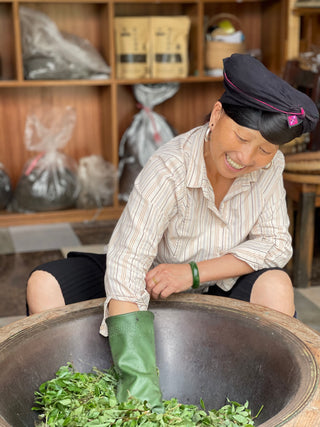***For reading the most recent update about this Beautiful Reason Initiative (BRI), please scroll down to the Project Updates Log or click here.***
Beautiful Reason Initiative #3: Longsheng Tea Brand
Table of Content:
LOCAL NEED
The Yao people live in a very suitable climate for tea cultivation. The combination of altitude, humidity, sunshine, and plenty of rain makes the Longsheng mountains an ideal environment for tea trees. Tea is therefore considered one of the three key resources in the area, together with bamboo and rice.
As much of the land is used for rice cultivation, and tea is considered a secondary industry, tea plantations are mostly found deep in the forests where they grow wild among a wide variety of other plants.
Over the years, this has led to countless wild tea plantations flourishing deep in the Longsheng mountains. This unique growing environment is different from other plantations, which often use massive inputs and cut down all other vegetation to stimulate the growth of the tea tree.
Originally, Longsheng tea leaves were used only for personal consumption. It's often enjoyed as the famous Yao beverage called "You Cha," which is made by heating the tea leaves in a wok and adding ginger and other spices. Locals say this vital drink helps them release the body's internal humidity and strengthens the immune system.
The Changing Times
Over the years, with the abundance of tea leaves and the economic pressures building, the Yao people decided to look for new markets for their tea leaves. This effort has slowly but surely changed the role that tea is playing in the life of the Yao people today.
To understand the tea industry in Longsheng, we made several trips to the area and met with local tea farmers. Unfortunately, when asked to share their thoughts about the Longsheng tea industry, they didn't seem too optimistic despite the increase in demand. Despite the demand for their high-quality tea, local farmers are at a disadvantage when negotiating with buyers.
Several reasons cause this:
- Longsheng Tea farmers lack the knowledge to make their tea leaves "market-friendly" and create flavor profiles that are popular with consumers. So, farmers often only sell raw leaves to tea companies who DO know how to make them market-friendly. Some local tea farmers have created their own blends but have had little success in creating a sustainable business from the endeavor.
- The unique fact that the tea plantations are wild also puts Longsheng farmers at a disadvantage. Although this characteristic is considered a desirable quality and a "unique selling point," it's a disadvantage when competing with highly industrialized tea farms that can produce larger quantities for less.
Both of these factors have caused the following situation:
- The Longsheng tea farmers have to compete with larger, industrialized tea crops and end up selling their tea at extremely low prices. The increased economic pressure faced by the village is the only reason why so many farmers choose to accept these marginal profits.
- Over the past 5-10 years, the tea farmers have started using chemicals on their ancient tea trees to increase their yield and stay competitive. This practice introduces harmful chemicals to the tea crop-- and the beautiful Longsheng mountains. And it causes the unique wild tea leaves to decrease in market value in exchange for short-term profit.
OPPORTUNITY (BRI)
We sat down with several tea farmers to learn how the situation could be improved. They all gave detailed answers and had clearly given this some thought -- they just weren't in a position to act. Collectively, the idea for a Longsheng all-natural tea brand was born.
With a Longsheng tea brand, farmers wouldn't have to sell their leaves at rock bottom prices or use harmful chemicals to boost their yields. Making the plan work would require bringing in tea mentors, setting up a local tea factory, and finding markets where local farmers can charge higher prices by connecting them with buyers who value the uniqueness and exclusivity of their wild tea trees.
Collectively we also discussed the topic of this new venture potentially exploiting local resources. However, after much talk, the villagers and Viori both believe investing in a sustainable local tea industry would actually prevent resources from being depleted. It would encourage more farmers to choose low-scale, high-quality production over low-quality, high-scale production.
Furthermore, the villagers shared how the local government doesn't allow the mountains to become large-scale tea plantations, so local laws are aligned with the sustainable vision.
TIMELINE 2021
- May-Sept: Rice Cultivation Season
- April: Longsheng Tea Research
- May: Invite Organic Tea Master to Longsheng
- June-July: Determine Location of Tea Factory
- Aug-Dec: Renovation of Tea Factory
2022:
- Jan-Feb: Purchase + Installation Equipment
- March: Harvest First Tea Batch
BUDGET
Last updated: June 10th, 2021

Project Updates Log
June 14, 2021: Potential Tea Factory Location

April 2, 2021: Tea master Chen visits Longsheng

March 1, 2021: Research into Longsheng Tea market


February 17, 2021: First Time Back
This was our first trip back to Longsheng since the start of COVID and travel challenges/restrictions.
We stayed in touch with local families throughout the year, but not having our team be on the ground in Longsheng felt unnatural, especially while our company was rapidly evolving to adjust to the circumstances.
So, this trip meant a lot to us...
And it was amazing. We are so grateful to have reconnected with our Longsheng friends in person and reaffirm our commitment to supporting their culture. We're also grateful for the stories and the laughs. We always have a great time on our visits.

This was such a unique trip that we wrote a separate article about it called 'Coming Home.' Read it here.
While listening to the stories shared by community members and restating our commitment to their sustainable development, we came up with some exciting ideas for supporting the Rice Farmers of Longsheng. Stay tuned for more!

